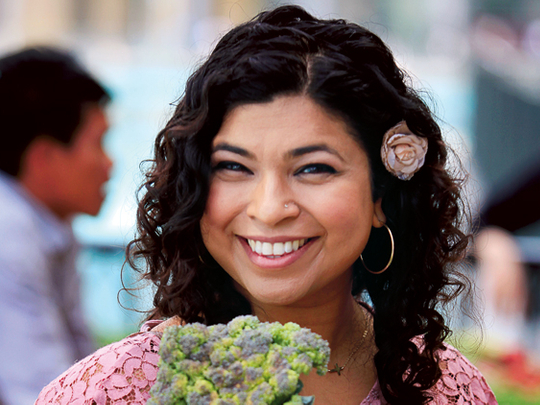
When Aarti Sequeira won the Food Network Star challenge in 2010, she knew what she would bring to her show's kitchen table, a laidback but flavour-packed blend of traditional Indian cooking techniques and ingredients with contemporary cuisine. Sequeira's eponymous show, Aarti Party, continues to present the art of comfortable cooking while taking a few new risks. From plating up sloppy Bombay Joes to whipping up broccoli and dill raita, the Dubai-raised Indian chef effortlessly leverages the globalised kitchen to great success.
I met Sequeira in the middle of a whirlwind trip to the UAE earlier this year to promote the third season of her show on Food Network (aired here on OSN) and to participate at the Taste of Dubai 2012. Sequeira has since expanded her range and now also hosts Hidden Eats on the Cooking Channel, exploring authentic cuisines in unlikely places.
Appropriately enough, we met at the Farmers' Market On The Terrace at Souk Al Bahar, where we picked our way past baskets of fresh produce as Sequeira chatted effortlessly with the farmers. Fans, both children and adult, swarmed around her, making conversation difficult. An hour later, we retired to the safety of a nearby cafe to talk food.
The cuisine pendulum
From food lover to TV chef, Sequeira's career has grown through her palate. 'I think the things I'm attracted to are still the same; in terms of food I've always loved big flavours. The growth, I think, is to have rediscovered subtle flavours and understand how beautiful just salt and pepper can be to make a dish spectacular," she says.
For thousands of years, Indian cuisine has been synonymous with complex flavours: spices, herbs and an eclectic blend of regional and cultural influences. However, within its multi-faceted legacy lie several tales of simplicity, which helped Sequeira discover what elevated a warm salad or a slow roast, both now beginning to find their way into the modern Indian kitchen. Roasting is a cooking method that Indians should use more often, she says. "It's easy and one of the best ways to enhance flavour and maximise use of the stove."
"Our food today is not just Indian; it has evolved over centuries with influences from the Moguls and Persians to the French, Portuguese and English. While I understand and identify with how protective we [Indians] can be about our cuisine, we need to realise that the changes and ingredients we let in so long ago was how our cuisine evolved. We need to let that happen again. We could even invent something that could become the new standard if we are open to it."
Indian food abroad
Having lived in different countries, Sequeira reports first-hand on the rate at which Indian food finds favour with other cultures. She points out how residents of the UAE have been around Indian food for so long that they are comfortable experimenting with it, while in the US, people are only just getting their head around Indian spices and cooking techniques. "I feel globalisation and the fusion of Indian flavours is excellent for our food and people; the best and most enjoyable way to get to know a culture is to experience its food."
While this is true, few cultures have entered the Indian kitchen in recent times.
Although Michelin-star chefs such as Atul Kochhar and Vineet Bhatia have spiced up poussin and foie gras to much acclaim, not many Indians would consider working with them at home.
Sequeira partly agrees. "My cooking style centres around the love for comfortable home cooking. So yes, while I have always found bringing Indian spices to Western food easy, the reverse has definitely been challenging, but not impossible. The line demarcating both areas is pretty soluble if you want it to be, and that's where experimenting with new ingredients comes in, and taking it slow, from ingredient to method to recipe."
This is true enough: when two cultures collide, food tends to evolve slowly, somewhere in between. "Rogan Josh did not happen overnight; it took its time and willingness to letting the spices travel into our lands and do its work," she says.
One step at a time
Sequeira's undeniable popularity comes from being able to break a complex recipe down to basics and then elevating it, before finishing off with her trademark giggle. "When I won [Food Network Star], I had emerged from six to eight weeks of cooking purely from gut instinct. It was manic, and constantly on the go, but at the end of it, I knew that past the haze, I wanted to keep cooking this way."
Sequeira's first order of business was to collaborate with the network to pare down the complexities and get to the heart of Indian coking. "Season one started with about five to seven basic spices in my masala dabba (box). We didn't want people to watch, get intimidated and then change channels; plus you can't look at a masala dabba and not get excited, I wanted to sustain that and build from there."
She has now progressed beyond putting earl grey tea and green cardamom into kulfi (Indian ice cream) to using tamarind paste at the heart of a BBQ sauce. "This seems to be working really well," she says.
Mixed responses
Western viewers have taken a shine to Sequeira's open and engaging cooking skills. As for her fellow Indians, it’s been an even keel: "I was really nervous; I thought they'd scream at me for diluting the culture but the support has been amazing!" She admits to having a couple of hecklers, who have squawked and then disappeared.
"We can be very critical of our own and people can be pretty awful if they want to be; but when you look at the positive, it outweighs everything else."
Returning to her childhood home, the UAE has transformed before Sequeira's eyes. "The sense of plentiful still remains; I remember my father's trips to Friday markets, wheel barrows teeming with fresh fare, but back then you needed to know how to cook what you bought."
Things have changed since. From the ubiquitous regional restaurant line-up of Middle Eastern, and South Asian fare that she remembers, she recalls how trips to the first nice Italian restaurant were for "special occasions or birthday dinners". "But now, there's fine dining everywhere, and people coming from all over the world to see how their creations do here. It's a gastronomic laboratory now!"
Scratch the surface, however, and Sequeira still believes that past the amazing development, deep in the alleys of old Dubai lies its true soul. "The sights, smells, that samosa guy on the corner and the street food, which I absolutely love, that's where it's all bubbling!"








